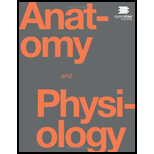
Concept explainers
Watch this video (http://openstaxcollege.org/l/DanielleReed) to learn about Dr. Danielle Reed of the Monell Chemical Senses Center in Philadelphia, PA, who became interested in science at an early age because of her sensory experiences. She recognized that her sense of taste was unique compared with other people she knew. Now, she studies the genetic differences between people and their sensitivities to taste stimuli. In the video, there is a brief image of a person sticking out their tongue, which has been covered with a colored dye. This is how Dr. Reed is able to visualize and count papillae on the surface of the tongue. People fall into two large groups known as “tasters” and “non-tasters” on the basis of the density of papillae on their tongue, which also indicates the number of taste buds. Non-tasters can taste food, but they are not as sensitive to certain tastes, such as bitterness. Dr. Reed discovered that she is a non-taster, which explains why she perceived bitterness differently than other people she knew. Are you very sensitive to tastes? Can you see any similarities among the members of your family?
To analyze:
Whether I am sensitive to taste and look for similarities among my family members.
Introduction:
The people sensitive taste possess more taste buds on their tongue compared to insensitive people. The sense of bitterness is one parameter that identifies one as a taste sensitive people.
Explanation of Solution
The taste buds are spread throughout the tongue surface. However, they are more concentrated on the posterior end of the tongue. This region is specific to bitter taste. Thus people with a higher density of taste buds are more sensitive to bitter taste. They can identify this taste more efficiently and quickly than others. Moreover, the glossopharyngeal and facial nerves carry stimuli of taste from two-thirds of the anterior surface of the tongue. The vagus nerve innervates the posterior end of the tongue sensitive to bitterness. Thus this difference in stimuli transmission to the brain specifically identifies the bitter taste and makes some people sensitive to this taste.
I am not sensitive to taste as bitter substances are equally palatable for me as other tastes. Most of my family members share this trait with me.
Bitterness sensitivity is one parameter to identify someone as sensitive to taste. This is due to presence of more number of taste buds on the anterior end of the tongue corresponding to bitter taste stimuli.
Want to see more full solutions like this?
Chapter 14 Solutions
Anatomy & Physiology
Additional Science Textbook Solutions
College Physics
Fundamentals of Anatomy & Physiology Plus Mastering A&P with eText - Access Card Package (10th Edition) (New A&P Titles by Ric Martini and Judi Nath)
Anatomy & Physiology
Human Biology: Concepts and Current Issues
Anatomy & Physiology (6th Edition)
Fundamentals of Anatomy & Physiology (11th Edition)
- Larry goes to the doctor complaining that he cant see the right side of the visual field with either eye. Where in the visual signal-processing pathway is Larrys problem occurring?arrow_forward___ is defined as a decrease in the response to an ongoing stimulus. a. Perception b. Visual accommodation c. Sensory adaptiltion d. Somatic sensationarrow_forwardJill is diagnosed with sensorineural deafness, a disorder in which sound waves are transmitted normally to the inner ear but they are not translated into neural signals that travel to the brain. Sometimes the cause is a problem with the auditory nerve, but in Jills case it has to do with a problem in the inner ear itself. Where in the inner ear is the disruption most likely to be located?arrow_forward
- Which of the special senses is based on the following events? Membrane vibrations cause fluid movements, which lead to bending of mechanoreceptors and firing of action potentials. a. taste b. smell c. hearing d. visionarrow_forwardMatch each of the following terms with the appropriate description. _____ somatic senses (general senses)a.produced by strong stimulation _____ special sensesb.endings of sensory neurons or specialized cells next to them _____ variations in stimulus intensity _____ action potentialc.taste, smell, hearing, balance, and vision _____ sensory receptord.frequency and number of action potentials e.touch, pressure, temperature, pain, and muscle sensearrow_forwardMany people experience motion sickness while traveling in a car. This sensation results from contradictory inputs arising from which senses? Proprioception and Kinesthesia Somatosensation and Equilibrium Gustation and Vibration Vision and Vestibular Systemarrow_forward
- How does the eye focus the light rays of an image? What do nearsighted and farsighted mean?arrow_forwardYour visual field is ______________. a. a specific, small area of the retina b. what you actually see c. the area where color vision occurs d. where the optic nerve startsarrow_forwardHow do somatic sensations differ from special senses?arrow_forward
- Awareness of a stimulus is called a ________.arrow_forwardThe sensory systems are complex and have the amazing ability to respond to different types of environmental stimuli. What is one aspect of the sensory systems we have looked at (gustatory, olfactory, or visual) that you found particularly interesting and would like to know more about?arrow_forwardName and define the stages of processing for our special senses.arrow_forward
 Anatomy & PhysiologyBiologyISBN:9781938168130Author:Kelly A. Young, James A. Wise, Peter DeSaix, Dean H. Kruse, Brandon Poe, Eddie Johnson, Jody E. Johnson, Oksana Korol, J. Gordon Betts, Mark WomblePublisher:OpenStax College
Anatomy & PhysiologyBiologyISBN:9781938168130Author:Kelly A. Young, James A. Wise, Peter DeSaix, Dean H. Kruse, Brandon Poe, Eddie Johnson, Jody E. Johnson, Oksana Korol, J. Gordon Betts, Mark WomblePublisher:OpenStax College Human Biology (MindTap Course List)BiologyISBN:9781305112100Author:Cecie Starr, Beverly McMillanPublisher:Cengage Learning
Human Biology (MindTap Course List)BiologyISBN:9781305112100Author:Cecie Starr, Beverly McMillanPublisher:Cengage Learning Biology 2eBiologyISBN:9781947172517Author:Matthew Douglas, Jung Choi, Mary Ann ClarkPublisher:OpenStax
Biology 2eBiologyISBN:9781947172517Author:Matthew Douglas, Jung Choi, Mary Ann ClarkPublisher:OpenStax Biology: The Unity and Diversity of Life (MindTap...BiologyISBN:9781305073951Author:Cecie Starr, Ralph Taggart, Christine Evers, Lisa StarrPublisher:Cengage Learning
Biology: The Unity and Diversity of Life (MindTap...BiologyISBN:9781305073951Author:Cecie Starr, Ralph Taggart, Christine Evers, Lisa StarrPublisher:Cengage Learning Biology (MindTap Course List)BiologyISBN:9781337392938Author:Eldra Solomon, Charles Martin, Diana W. Martin, Linda R. BergPublisher:Cengage Learning
Biology (MindTap Course List)BiologyISBN:9781337392938Author:Eldra Solomon, Charles Martin, Diana W. Martin, Linda R. BergPublisher:Cengage Learning





